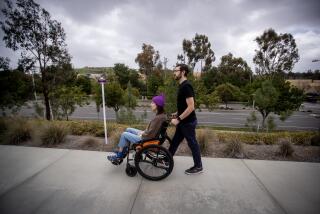Older adults at higher risk of long COVID; shots don’t prevent it

- Share via
New U.S. research on long COVID provides fresh evidence that it can occur after breakthrough infections in vaccinated people, and that older adults face higher risks for suffering the long-term effects.
In a study of veterans published Wednesday, about one-third who had breakthrough infections showed signs of long COVID.
A separate report from the Centers for Disease Control and Prevention found that up to a year after an initial coronavirus infection, 1 in 4 adults ages 65 and older had at least one potential long COVID health problem, compared with 1 in 5 younger adults.
Long COVID refers to any of more than two dozen symptoms that linger, recur or first appear at least one month after a coronavirus infection. These can affect all parts of the body and may include fatigue, shortness of breath, brain fog and blood clots.
Coronavirus vaccines that help prevent initial infections and serious illnesses provide some protection against long COVID, but mounting research shows that it’s not as much as scientists had first hoped.
The veterans study, published in Nature Medicine, reviewed medical records of mostly white male veterans, whose average age was 60. Of the 13 million veterans, almost 3 million had been vaccinated as of October. About 1%, or nearly 34,000, developed breakthrough infections.
Researchers are getting serious about understanding a disease patients call “long COVID.” Its symptoms include aches, fatigue, sleep problems and brain fog.
Breakthrough infections and long COVID symptoms were more common among those who had received Johnson & Johnson’s single-dose shot compared with two doses of either Moderna or Pfizer vaccines, Spikevax and Comirnaty. Whether any had received booster shots is not known; the first booster wasn’t authorized in the U.S. until late September.
Overall, 32% had long COVID symptoms up to six months after breakthrough infections. Among the unvaccinated veterans who had become infected, 36% developed long COVID symptoms.
Vaccination was associated with a “modest” 15% reduced chance of developing any long COVID symptoms, said study lead author Dr. Ziyad Al-Aly, a researcher with Washington University in St. Louis and the Veterans Affairs health system there. However, those who were vaccinated were half as likely to suffer lingering respiratory or clotting problems, including persistent shortness of breath or cough and blood clots in the lungs or veins in the legs.
Al-Aly noted that the study was done before the highly contagious Omicron variant appeared at the end of the year and said the rate of breakthrough infections has likely increased.
Infectious-disease expert Dr. Kristin Englund, who runs a center for long COVID patients at the Cleveland Clinic, said the Nature Medicine study mirrors what she sees in her practice. Long COVID patients there include people who were vaccinated and received boosters.
“As we have no clear treatments for long COVID, it is important for everyone to get vaccinated and use other proven methods of prevention such as masking and social distancing in order to prevent infections with COVID and thus long COVID,’’ she said.
More than a year after he was infected with the coronavirus, 14-year-old Ami Korn, who now lives in Georgia, is still struggling to fully recover.
The CDC report, released Tuesday, is based on medical records for almost 2 million U.S. adults from the start of the pandemic in March 2020 to last November. They included 353,000 who had COVID-19. Patients were tracked for up to a year to determine whether they developed any of 26 health conditions that have been attributed to long COVID.
Those who’d had COVID-19 were much more likely than adults who hadn’t to develop at least one of these conditions, and the risks were greatest for those ages 65 and older. Information on vaccination status, sex and race was not included.
Breathing problems and muscle aches were among the most common conditions. Older adults’ risks were higher for certain conditions, including strokes, brain fog, kidney failure and mental health problems.
The findings are worrisome because those conditions can hasten older adults’ needs for long-term care, the report authors said.
They stressed that a routine assessment of all COVID-19 patients “is critical to reduce the incidence” of long COVID.







